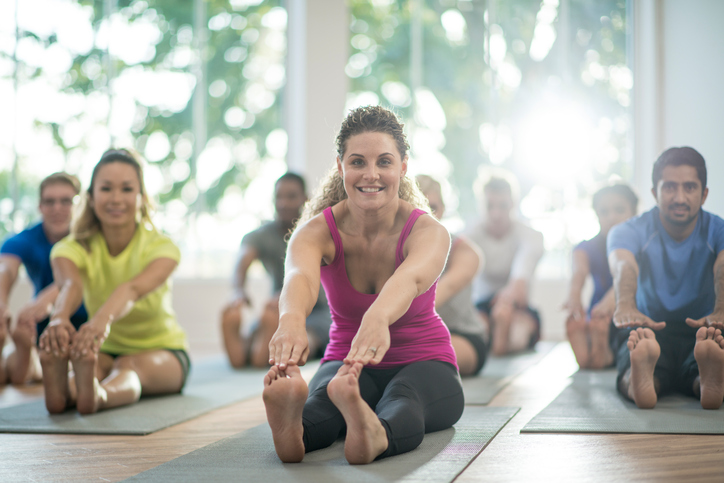15 Surprising Health Benefits of Yoga For Both Mind & Body

Yoga seems to be all the rage these days. For good reason! Did you know it’s a legitimate way to increase your fitness and that there are many surprising health benefits of yoga? It’s true!
First off, what is yoga? The word yoga means to “yoke” or “unite” the body and spirit. It is a physical practice of stretching, holds, breathing techniques, and flexibility moves that help you become aware of your body and become one with it.
There are many types of yoga. The most recognized, mainstream type of yoga is probably the practice known as “Hatha” yoga. But, there are other types, each with their own specific purposes. In alphabetical order, they are:
- Ashtanga—links movement to breath and is often described as a modern-day form of classical yoga, which originated in India.
- Bikram—this is a type of hatha yoga using a specific set of 26 postures and breathing exercises that’s performed in a hot and humid room (set at 105 degrees with 40% humidity).
- Hatha—is one of the most common. It’s a great style for beginners which combines physical exercises with breath control.
- Iyengar—another form of Hatha yoga that emphasizes precision and alignment. It’s thought to be ideal for people with neck and back problems.
- Jivamukti—yet another form of Hatha yoga that’s quite vigorous. It typically involves a theme with each session and teaches aspects of yoga.
- Kripalu—promotes learning about your body with an emphasis on meditation and breathwork. It focuses not just on the movement but on an inward focus. It is also considered a form of Hatha yoga.
- Kundalini—literally means “coiled snake” and is believed to help release energy coiled at the base of the spine.
- Power—is a popular yoga style designed to burn calories and strengthen your body with a fitness-based approach.
- Prenatal—is to assist in keeping pregnant women healthy and flexible and to aid them in getting back into shape after pregnancy.
- Restorative—designed to promote relaxation through a series of gentle poses. Props are encouraged to help make the poses easier.
- Sivananda—is a practice that brings diet and exercise, thinking, breathing, and relaxation together for maximum impact. This is another form of Hatha yoga focused on health and wellness.
- Viniyoga—a faster-paced, therapeutic style of hatha yoga that’s great for weight loss.
- Yin—a slow-paced, passive form of postures, also known as asanas, designed to stretch and release tension from joints with the use of gravity.
What are the Health Benefits of Yoga?
When you think of the health benefits of yoga, flexibility is likely the first thing to come to mind. That is indeed a major benefit of yoga. But, there are many other (and some surprising) benefits to yoga. We list a few of the health issues here that may be improved through the use of yoga.
Reducing Anxiety, Stress, and Depression—yoga is well-known for helping you relax and let the stress and worry melt from your body. According to a study performed in 2013, anxiety and depression were reduced, and future episodes even prevented, through the use of a regular yoga routine.
Arthritis Relief—while there are more studies needed, initial results are promising when it comes to using yoga as a means for reducing the severity of arthritis symptoms. A study published in Clinical Interventions in Aging, showed the practice of yoga is an effective aide for arthritic patients, allowing them to experience relief when combined with their medical protocols.
Improving Balance—according to a 2014 study in Contemporary Nurse, folks practicing yoga were able to improve their overall balance. Since yoga encourages flexibility, strength, muscle tone, and balance (attributes often lacking as we get older), older folks who engaged in gentle yoga practices were seen to improve their ability to balance and also enjoyed improvements in their overall quality of life.
Relief for Menopause, Fatigue, and Cancer Treatment Side Effects—according to a 2014 study published in Clinical Interventions in Aging, menopausal women who practiced yoga for 18 weeks experienced renewed energy and a sense of freedom, which greatly improved their quality of life.
A University of Calgary study also showed a 6-week yoga routine to be beneficial in lessening the uncomfortable side effects of cancer treatments. For example, patients who practiced yoga experienced less nausea and less fatigue. They were also better able to deal with the emotional aspects of being ill such as depression, anger, confusion, irritability, and tension.
Helping Hypertension—the Department of Exercise and Wellness at Arizona State University showed that after 6 weeks of practicing yoga, participants enjoyed vast improvement in their levels of stress, had decreased blood pressure readings, and boasted greater endurance, flexibility, as well as upper body strength.
Pain Management—studies show that yoga is an effective means of relieving pain. Because it promotes flexibility and nourishing blood flow, it also helps boost the immune system. And, the movement helps to release serotonin, a feel-good hormone, which in turn, reduces the sensation of pain.
Migraine Relaxation—because yoga helps improve blood flow and promotes relaxation, studies show it can be an effective form of supplemental treatment for those who suffer from migraines.
Pregnancy Support—yoga has long been used as a method to improve breathing and relaxation as well as reduce anxiety while pregnant. The practice of yoga can also be of assistance long term in preventing post-partum depression.
Battling Sleep Problems, such as Restless Leg Syndrome—studies show that yoga participants are able to achieve a more restful sleep, tend to sleep longer, wake up less, and fall asleep faster. It has even been shown that in as little as eight weeks, yoga can help greatly reduce, or even eliminate, restless leg syndrome, thereby promoting improved sleep.
Support Weight Management—yoga helps strengthen muscles and improve flexibility. And certain styles can even burn significant calories. Not only that, but the practice of yoga itself, along with the deep breathing and relaxing states you achieve, can help reduce your levels of the stress hormone cortisol. Reduced amounts of cortisol may allow you to burn fat more easily as well as lower the chance of storing it as readily.
Honestly, I could continue with this list. There are so many health benefits of yoga that can be positively attributed to a consistent regimen.

Simple Yoga Moves to Try Now
Now, it’s your turn! Take a minute to try each of these simple moves and enjoy the awesome health benefits of yoga.
Downward Dog (aka Downward-Facing Dog, Down Dog, and Adho Mukha Svanasana)—one of the most well-known yoga poses, it’s a mainstay in many yoga routines and helps to stretch and strengthen the whole body. To begin, get onto the ground on all fours. Then lift your hips into the air as you straighten your knees and arms, forming an inverted V with your body. Stretch your fingers wide as you press firmly into your hands. And drive your heels down toward the ground as y ou breathe deeply. Hold this position for 5 to 10 breaths, and then return to the starting position.
Plank (aka Kumbhakasana)—you may have heard of this one or seen folks performing the movement at the gym. Touted as an abdominal exercise, this yoga move works to strengthen the entire body as you stabilize your body with your abs.
Start by kneeling on all fours on a mat. Next, lift your knees off the ground and straighten them, pushing through your toes, until your shoulders and arms form a straight line. (Like the top position of a pushup.) Your spine will be in a straight line from the top of your head to the base of your spine. Pull your belly button in toward your spine, and hold this position for a count of 10 breaths and release, moving back to your original position on your hands and knees. If this is difficult for you, you can also start with your knees on the ground and work your way up to the full body plank.
Child’s Pose (aka Balasana)—this restful pose is a great way to end a yoga session, a tough workout, or even a long day. It’s also used throughout your yoga practice, whenever you need a rest.
Start by sitting up straight with your butt on your heels with your knees spread apart and your toes touching. Lean forward gently at the hips, curving your body until your torso is resting comfortably between your thighs. There are two versions of Child’s Pose—you can keep your arms straight behind you as you lower your head toward the floor or rest your forehead against the floor—as long as it’s comfortable for you. Or you can stretch your arms above your head, resting your forearms and slightly bent elbows on the floor in Extended Child’s Pose. Relax in this position until you feel all the tension drain from your body.
Now that you know the surprising health benefits of yoga and some simple poses to get you started, I wish you Namaste, which loosely translated means, I acknowledge you with respect. Enjoy!







